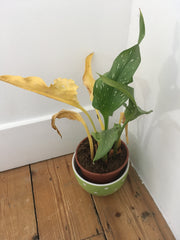Must have guide to Red Spider Mite and their treatments
What are Red Spider Mite?
Spider Mites are less than 1mm in size and difficult to see without a lens or microscope unless you have very sharp eyes. They often live underneath leaves, and are only active when it is warm. So can be around all year in houseplant collections. Outside in winter they hibernate either as eggs, or inactive newborns which you can often spot as tiny cream, red or orange shiny dots.

What does spider mite damage look like? The symptoms

A very sick lily
How do you stop Red Spider Mite?
Depending on your growing conditions, it is a good idea to inspect vulnerable plants every week and deal with the first signs of mite infestation immediately. Where possible, remove infested leaves, buds and stems because this will initially reduce numbers. If there is any part of the plant which is covered in cobwebs then regrettably it will need to be sacrificed as it will not recover. Spider mites prefer hot dry environments, so spraying the infested areas of a plant with cold water and, in greenhouses, damping the floor areas will raise the humidity and hopefully slow the infestation rate.
When the infestation becomes advanced, fine webbing appears on new growth. Spider mites are arachnids (spiders) and can spin very extensive fine webs. The webbing acts to shield the colony like a blanket, and it also provides a series of ladders or netting which allow the mites to crawl from stem to stem. Where webbing is widespread the leaves will typically turn brown and drop off because of the extent of the cell damage.
Red Spider Mite Treatments
We sell two biological controls to tackle the mites, Phytoseiulus persimilis mites which are the best at treating an outbreak and Amblyseius Andersoni which is useful as as a preventative measure indoors or in March or April when you can't yet see any spider mite - or later in the year for small outbreaks.
Go to red spider mite controls





